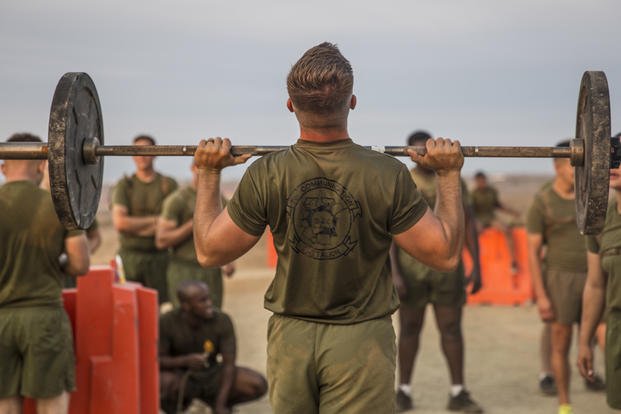Many people confuse the training programs done by groups, like active-duty special ops, to meet the demands of the profession with how they prepare for more challenging schools like Basic Underwater Demolition/SEAL (BUD/S), for example.
Here is a question to better describe a very common issue with the candidate training program selection process:
Stew, I have been watching some YouTube videos showing active-duty special-ops guys working out like SEALs, Rangers, SF and others. They are huge and lifting very heavy weights so I have been lifting more and doing less cardio. Is this OK? I am preparing for BUD/S for the next year and trying to gain some muscle mass.
The short answer to your question is yes. This is fine, but you want to arrange the workouts where you decrease your cardio and increase your weight training so you cycle through this type of training for 6-8 weeks -- maybe 12 weeks if you have a year to train.
Where some special-ops candidates make mistakes is that they fail to drop the heavy weights and switch to higher-repetition calisthenics to help with muscle stamina, and they fail to get good at running, rucking and swimming fast and with high mileage per week. Many people have said, including myself, that they never once wished they had lifted more weights at BUD/S. They wished they had run more or swam more with fins.
For the past 15 years, I have been teaching and performing personally a winter weightlifting cycle that reduces repetitions and running distances to give the joints a recovery period from high reps and impact miles. However, for BUD/S candidates, I recommend this is a great time to add in a progressive swimming with fins cycle for extra cardio work. Add rucking in as well if your branch of service training specifically tests that skill, too. Here's how to incorporate periodization throughout the year.
Making it to training programs requires you to train specifically for a fitness test. This has been where I have been specializing for more than 15 years now.
Here is how to approach tactical professions:
Pre-training: Acing the fitness test and building a foundation of fitness so your body can handle the actual training of BUD/S, SF, PJ (pararescue), fire and police academies is the specific focus on training you must have. This process can take 1-2 years, depending on your starting fitness level, or as little as 4-6 months, depending on your athletic history. Regardless, you do not want to go to any training program without having reached near the maximum standards of the fitness requirements. Otherwise, the likelihood of injury, failure and other delays are certain. You have to "train for the training."
Specificity also is required to get through the training after you have focused much of your exercise on making it to the training. If your training program requires graded four-mile timed runs, two-mile ocean swims, long runs and rucks, and hundreds of reps of calisthenics several times a week, you need to practice those events and get your run/swim/ruck mile pace down to an acceptable level to ensure success.
Post-training: After the shock of special-ops selections, training, other boot camps and academies, you have to focus now on the profession's demands tactically and physically. This is where the teams, Ranger battalions and special forces groups have advanced their programming by hiring actual strength and conditioning scientists and coaches to create functional programs and testing criteria to help make a better operator. There are many elements to consider in creating, building and maintaining a special operator foundation of tactical fitness:
- The constant needs of high-repetition calisthenics and long miles of run, ruck or swimming (or all the above) are decreased. Now focus on speed, agility, balance, flexibility, strength, power, endurance and muscle stamina.
- Periodization, or breaking your training into cycles, is critical to the health and longevity of any athlete. There is no offseason for the tactical athlete.
- Tactical athletes must get more creative to adjust the workouts so they can pursue recovery actively, even during times of interrupted sleeping patterns and ineffective nutrition options.
- Recovery from stress is the key. There has to be down times in your training cycles, even if that recovery period is just moments of deep breathing or relaxing before sleeping or napping. Learn how to adjust workouts to fit the seasonal demands of your profession.
The fitness foundation needed to make it through the training will build off of the PFT scores and should advance with the specifics of the training required (PT, run, ruck, swim, logs, boats, etc.). Finally, the training you will need to perform the actual job of the tactical operator will differ tremendously, and it should take you back to the days of sports training, where you focused on speed, agility, balance, flexibility, strength, power, endurance and muscle stamina to help you perform a specific skill at your optimal level.
Here is a related audio interview I did recently that touched on this subject.
Stew Smith is a former Navy SEAL and fitness author certified as a Strength and Conditioning Specialist (CSCS) with the National Strength and Conditioning Association. Visit his Fitness eBook store if you're looking to start a workout program to create a healthy lifestyle. Send your fitness questions to stew@stewsmith.com.
Want to Learn More About Military Life?
Whether you're thinking of joining the military, looking for fitness and basic training tips, or keeping up with military life and benefits, Military.com has you covered. Subscribe to Military.com to have military news, updates and resources delivered directly to your inbox.



















